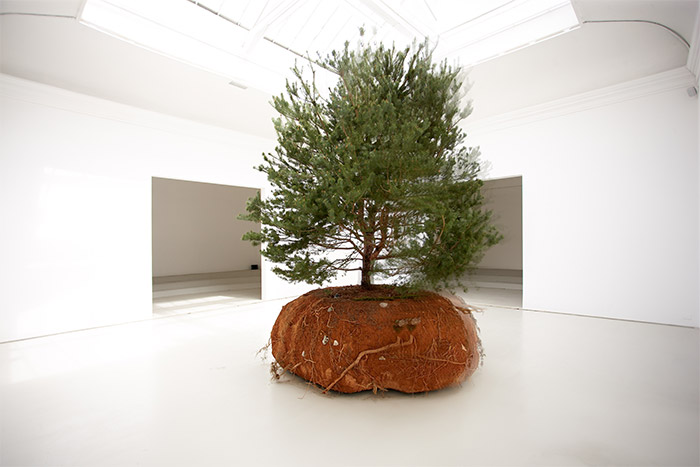Frenc Pavilion
Céleste Boursier-Mougenot "Rêvolutions"
Pavilion at Giardini

The work
Emma Lavigne. Curator, French pavilion
The French Pavilion at la Biennale di Venezia is open to the elements, conjuring up in the Giardini the “follies” of the romantic parks of the 18th century. Now it has become the theatre of an apparition, of an experimental ecosystem that reveals a state of nature unlike any other.
Under the skylight stripped of its glass and in its wooded walkways, Céleste Boursier-Mougenot o!ers the choreographic alchemy of three trees moving in time with their metabolism, variations in their sap flow and their sensitivity to light and shade. Behind these chimeras – these machine/nature hybrids – lies an animist vision of trees.
As in Francesco Colonna’s enigmatic novel The Dream of Poliphilus and Primo Levi’s short story Dysphylaxis, we see trees metamorphosing into transhuman creatures suddenly liberated from their rootedness to the ground.
While rekindling the aspiration to the marvellous and the sense of wonder of Italian Mannerist gardens, Céleste Boursier-Mougenot's work transHumUs lets the underlying political thrust filter through. His intention here is to commandeer systems used for controlling living beings and their movements and compose a poetic work o!ering humanity living spaces marked by liberty and unconventional beauty. Surrounded by trees whose electric rustling generates a
real-time sound environment based on di!erential low-voltage current, the French pavilion is transformed into an open-air theatre: a refuge where the visitor can find a place to relax – to float, as it were, on the semicircle of les marches (the steps) which imitate those of the portico but adapt to the
shape of the body – in a harmonious continuum conducive to reverie and reflection.
Around the work
”Rêvolutions participates in the substantialist metaphysics of space developed by Aristotle in the Physics, which envisages place as an attribute of the body. Like the Theater for Eternal Music and the Dream House (1962-1990) of La Monte Young and of Marian Zazeela, rêvolutions is a continuous musical environment without beginning or end where ‘the music seems to come not only from the inside of our head’, as Dan Graham remarks à propos of the work of La Monte Young, ‘but from our own perceptive process’. In the work of Céleste Boursier-Mougenot, as in that of La Monte Young, ‘the sound bounces against the walls and the architecture as one moves. One is in fact at the interior of the production of sound by the architecture and by one’s own perceptive process. The sound is materialized.’"1 (…)
rêvolutions is also a circus, where the living being ripped from the earth is put on display, an arena of combat, that of nature transmuted into instrument,
with an uprooting of identity. Yet the French Pavilion is also a possible refuge, open, for repose, for those whom like Roland Barthes in his Discours Amoureux
(A Lover’s Discourse) wish sometimes to return to their origin, to the roots, ‘from the midst of the tempest which uproots me, dispossesses me of my identity, I
sometimes want to return to the origin, my origin’. The visitor can pause, to take root contemplating these chimeras, hybrids of machine and nature (…)
Céleste Boursier-Mougenot comes to capture the harmony and the unheard resonances of a world in mutation furrowed by dissonances; and to bring it about
that the procedural sonorities of Robert Morris’ music box, the electrical and vegetable short circuits, sound in unison with the verses of the poet Rainer Maria Rilke in his Distant Song, which suddenly seems, in the pavilion open to the sky and the tree-lined alleys, so close: ‘What a shadow in the instrument, and what a murmur, of the forests from whence issued its wood’. ”
Emma Lavigne : Extracts from the text “Pavilion with The Sound of its Own Making”
 Celeste Boursier-Mougenot. French pavilion Venice Art Biennale
Celeste Boursier-Mougenot. French pavilion Venice Art Biennale
Céleste Boursier-Mougenot
I want to invite viewers to an ensemble of sensory experiences that blur the antitheses between human and vegetal, machines and living organisms, inside and outside, fixed and mobile, fast and slow. For example I use low-voltage electrical currents to make trees move around inside the pavilion. I create landscapes and soundscapes that allow for a different experience of time and space and a renewed way of listening, looking, sensing…
In many ways, no, but the context of the Giardini and of national pavilions is of course important. I am interested in challenging architecture as boundary (not just physical but also national), in turning space inside out, inviting the garden inside…
I don’t think in terms of ‘representation.’ I am more interested in how a soundscape can lead to a new form of listening, to a sensory openness, and that may have individual but also social implications.
Curator: Emma Lavigne
Commissioner: Institut Français, Ministère de la Culture et de la Communication






 Celeste Boursier-Mougenot. French pavilion Venice Art Biennale
Celeste Boursier-Mougenot. French pavilion Venice Art Biennale